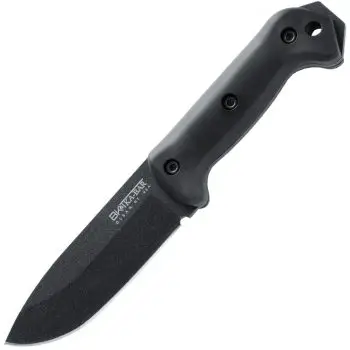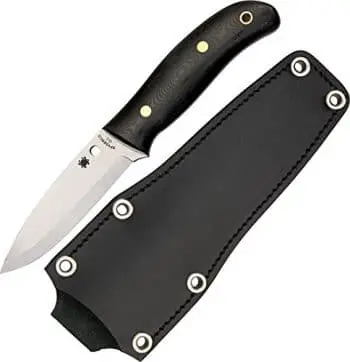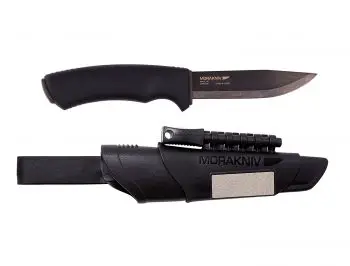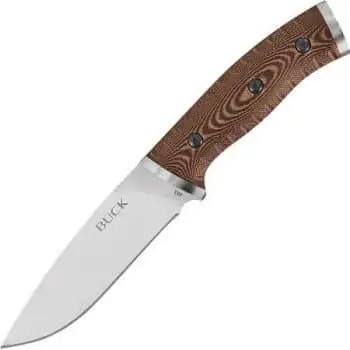Among survivalists and outdoorsman, a heated topic of debate has long been what one tool is the most valuable. If you could only take one item with you into the wild what would it be? There is really no wrong answer to this question but for most people the only real option is a bushcraft knife.
What makes a bushcraft knife so important to a successful adventure in the great outdoors? Bushcraft style knives are designed specifically to be versatile. When you only have one knife strapped to your hip that blade needs to be able to handle whatever mother nature throws at you. And handle it well.
Bushcraft is not survival. Bushcraft is about thriving in the wilderness. Hunting, digging, building shelters, processing wood, and carving are all primary duties of a knife for the skilled outdoorsman. A knife that can accomplish all of these tasks and be rugged enough to hold up under extreme use is worth the extra research it takes to find the very best.
Features to Look for When Choosing a Knife
On the surface, most knives look pretty similar. You have a handle and a blade. Pretty basic stuff. But important differences exist which contribute greatly to how well a knife functions, how durable it will prove to be, and how useful it will become for your individual needs.
This list of features provides some information about what to look for when comparing one knife with another.
Blade Material
The most common materials for knife blades are high carbon steel and stainless steel. Other possibilities include ceramics and alloys but these are not used frequently. All steel is stainless to a point and all steel has some amount of carbon present.
Stainless steel is steel with low carbon levels and high chromium levels making the material very hard and corrosion (rust) resistant. The complaint about stainless steel blades is the harder the steel, the more difficult to maintain a sharp edge on the blade.
High carbon products are much easier to hone to a razor-sharp edge and will maintain this edge far longer than stainless steel. Of course, high carbon requires maintenance to keep from corroding over time.
Grip (Scale)
The grip on a knife is often split and is attached in two pieces on either side of the spine. These pieces are called scales. Scales are made from many materials ranging from soft rubber to laminated cloth. Grips should provide comfort, be textured for handling when wet, be easy to clean, and be attached to the knife securely.
Blade Size and Shape
Blades come in many sizes and shapes and serve many purposes. For buschcrafting blade size and shape needs to accommodate versatility. Too small and the tool will not perform well when processing wood or digging a latrine.
Too large and carving notches for a shelter frame or whittling a spoon becomes awkward and unsafe. Most high functioning knives have a simple drop point with a sharp end for boring holes. In bushcraft there is no real tactical need for a double-sided blade so all of our examples are single sided.
Guard
The guard refers to the area between the blade and the handle. Some knives are designed with a pronounced ridge which serves to protect your hand from slipping on to the blade. This ridge is called a guard, bolster, or quillon depending on the form it takes.
Most outdoorsman prefer a guard for the safety it provides. However, some believe that it gets in the way when skinning or processing food. The lack of a guard can be at least partially overcome by ensuring the knife has a good grip.
Sheath
Sheaths are important for several reasons. Your sheath must be comfortable to wear as you will most likely have your knife on you at all times in the wilderness. If style is important to you, the sheath is an opportunity to express yourself. Many people prefer to have all their gear match. What is sometimes lost is the function the sheath performs.
Sheaths protect you from being accidently cut so a good sheath holds the blade securely. Undoubtedly you will invest a good deal of time sharpening your knife so select a sheath which preserves the edge rather than dulls it. To avoid filing off the edge of your knife choose leather.
If you prefer Kydex or glass reinforced nylon, ensure the blade does not touch the sheath when secured.
Weight
The weight of a tool sometimes determines how consistently you carry it with you. Most full time carry knives are considerably less than a pound for this reason. But if the knife is too light, it might not perform all of the tasks you need.
For instance, a knife made lighter by thinning the blade and spine will not last long when you go to baton wood. If you carry a saw and hatchet in your pack, go with the lighter blades.
Grind
Grind refers to the actual edge of the blade. There are many techniques to honing an edge and the distinctions between the grinds can be very complicated. A flat grind is simply a “v” shaped edge. A bevel grind is both sides of the v being rounded. This is sometimes referred to as a “Scandinavian” grind.
A compound bevel is an edge that changes the angle of the v near the end while still remaining rounded. Each technique has strengths and weaknesses but the compound bevel is generally regarded as the best compromise between sharpness and durability. It is not easy to sharpen, however.
Tang Design
Tang refers to how far down the length of the knife one continuous piece of metal extends. Full tang is metal from pommel to tip. Partial tang is a nice way to say a knife is not full tang. A full tang knife is stronger and usually better balanced. Also, the pommel, or butt, can often be used as a hammer due to the metal present there.
Full tang is also more expensive to make as it requires more materials and results in a heavier tool. Several manufacturers attempt to split the difference by offering stick, or rat-tail, full tangs where the metal narrows considerable when it reaches the handle but still extends the length of the implement.
As you can see, a lot of thought goes into crafting an excellent knife. Now that you are aware of the features available we can take a look at some of the best knives on the market and see how they stack up.
The Top Bushcraft Knifes
Ka-Bar Becker BK2
Weight: 16 Ounces
Dimensions: 10.5 Inches Long 5.5 Inch Blade Length
Specific Features: 1095 Cor-Van Steel Blade, Drop Point Bade, 20 Degree Flat Grind Edge, Full Tang, Glass-Filled Nylon Sheath, Grivory Handle
Best Use: Hunting, Cooking, Skinning, Rough Cutting Wood (Baton Method).
Ka-Bar knives have been around a long time and have an impressive history as the knife of choice for the American Military. Ka-Bars are known for being big, brutal looking tools and the Ka-Bar Becker BK2 is no exception.
In fact, the first thing you notice about this knife is how much bigger and heavier it is than the other entrants on our list. I should confess, I like big knives and own several Ka-Bars, including a monstrous Bowie. But I also carry a small necker knife for detailed carving and some skinning purposes. It covers all the tasks the BK2 would be too large to handle delicately and comfortably.
If you are comfortable with the size, the other features of the Ka-Bar are quite impressive. Made from 1095 Cor-Van Steel the knife will resist corrosion and hold an edge. The 20-degree flat grind edge is tough and relatively easy to sharpen.
A knife this size is begging to be used to baton wood and the full tang construction will help prevent damage to the tool when used in this capacity. After experiencing the Ka-Bar grips, I would opt for the upgrade to a Micarta grip.
Even though it adds $40 to a $75 knife, the addition of the laminated canvas scales would really make this knife spectacular. This is a big knife and the better you can grip it the safer it will be.
Fallkniven F1
Weight: 6.4 Ounces
Dimensions: 8.25 Inches Long 3.75 Inch Blade Length
Specific Features: VG-10 Stainless Steel Drop Point Blade With Satin Finish, Convex Grind, Textured Thermorun Elastomer Handle, Full Tang
Best Use: All Wood Processing and Carving, Skinning, and Cooking
Fallkniven is a Swedish manufacturer of quality knives and this knife is reported to be included in the downed pilot survival bag used by the Swedish Military. At first glance the Fallkniven F1 appears to be a no-nonsense well-constructed tool.
The high quality stainless steel material and convex grind combine to produce a knife that is razor sharp and will stay that way. Good thing, because sharpening a true convex blade takes some skill. But it can be done.
The blade length is a little short for my liking at less than 4 inches and the knife itself is pretty light at only 6.4 ounces. These dimensions almost put the F1 into the secondary knife category. I definitely would not try to really pound on this tool or use it as a pry bar even though it is full tang.
But for carving, light wood processing, and animal processing the smaller blade will really shine. I’m not sure if it suits all of my needs as a primary bushcraft blade, but I can definitely see the value the F1 provides due to its great construction.
Spyderco Bushcraft G10
Weight: 7.75 Ounces
Dimensions: 8.75 Inches Long 4 Inch Blade Length
Specific Features: O1 High Carbon Tool Steel, Scandinavian Grind, G-10 Handle, Blade Hole, Full Tang
Best Use: Processing Wood, Skinning, Carving, and Cooking
No discussion about great knives is complete unless a Spyderco model is mentioned.
This knife manufacturer has been consistently producing premium blades for more than 35 years. Spyderco is known for the quality of their products and the G10 is no exception.
A full tang, high carbon steel tool, the Spyderco Bushcraft G10 is made to be kept razor sharp. To help this along, a Scandinavian grind was added. When properly maintained, this combination is awesome, but it requires maintenance. Like, wipe it down and sharpen after each trip kind of maintenance.
If the extra work doesn’t scare you off this knife might be the perfect knife for your needs. It is a mid-weight knife for this class at 7.75 ounces and comes in at less than 9 inches with a full four-inch blade. The handle is textured for grip and contoured to ergonomically fit your hand.
While preventing fatigue over hours of use, the bend in the grip and the shape of the pommel make this knife difficult to hammer on without damaging your investment. Personally, I want more functionality per dollar spent, not less.
But if you are looking for an amazing blade and have other tools to do the truly heavy lifting around camp, maybe it’s time you owned a Spyderco. It is unlikely you will find a better blade.
Morakniv Knife with Firestarter
Weight: 5.4 Ounces
Dimensions: 9.1 Inches Long 4.3 Inch Blade Length
Specific Features: Carbon Steel Blade With Anti-Corrosive Coating, Black Plastic Sheath With Integrated Diamond Sharpener And Fire Starter, High Friction Rubber Grip
Best Use: Light Wood Processing, Carving, Cooking, Skinning
I was excited to include this Morakniv Survival knife on the list. Mora style knives represent a different type of construction, resulting in lighter knives due to their partial tang design. As you can see, this is the lightest knife on the list at only 5.4 ounces. But don’t let that fool you into thinking the blade is diminutive.
The business end of this Morakniv Knife with Firestarter is 4.3 inches long and a full eighth of an inch thick. A special hardening process is used on the high carbon steel to ensure the most durable product possible. It is the only knife I have seen recommended for batoning with a partial tang.
Knives of this type have been manufactured in Mora, Sweden since 1891 and Morakniv is a firm believer in the Mora knife design. In this survival knife I noticed the design differs from a traditional Mora with the inclusion of a substantial guard to protect your fingers, something the traditional Mora does not include.
The Morakniv also has a fire starter integrated into the sheath which must come in handy during the cold Swedish nights. If you like light knives, the Morakniv is for you.
Condor Bushlore
Weight: 12.8 Ounces
Dimensions: 10.5 Inches Long
Specific Features: Oversized Walnut Handle, Nickle Finish Blade, Full Tang, Sabre Grind, 1075 High Carbon Steel Blade.
Best Use: Wood Processing, Cooking, Hunting
The Condor Bushlore is a beautiful knife. With a polished walnut grip and satin finish on the high carbon steel blade, Condor was correct in giving this blade a leather sheath. They go together. The wood makes the tool come in a little heavy at 12.8 ounces, but it is not the heaviest on our list.
Condor calls the edge a “sabre grind” which seems to be similar to a high flat grind. Over time sharpening this knife on the factory 9-degree bevel will produce almost a straight razor effect. Definitely sharp but not a durable edge capable of standing up to the abuse of a camp knife.
For cooking and simple wood processing I believe the Bushlore would perform well. I have reservations about relying on this knife as a true bushcraft tool.
The walnut grip lacks texture to maintain grip when wet and the design has no guard present. Gutting a deer with this blade could be very dangerous if your knife was deep in the cavity and you hit bone.
Buck Knives Selkirk Knife
Weight: 6 Ounces
Dimensions: 5 Inches Long 4.5 Inch Blade Length
Specific Features: 420 High Carbon Steel Drop Point Blade. Two-Tone Micarta Handle, Reinforced Steel Bolster, 2.5 Inch Ferrocerium Striker Integrated Into Sheath, Full Tang
Best Use: Wood Processing, Carving, Cooking, Hunting, Skinning
My first knife was a Buck and I still own several. The Buck Knives Selkirk Knife displays many of the same design features and material choices that have made Buck a leader in knife manufacturing for more than 100 years. The 4.5-inch-high carbon steel blade tapers to a drop point.
The grip is fashioned from high quality Micarta. The Selkirk goes the extra step and keeps a pronounced steel pommel. Most Micarta gripped knives do not. Included is a ferro rod, integrated into the injected molded nylon sheath. The firestarter is a nice touch but I hesitate to carry my own anywhere but in a zipped pocket.
It is not a tool that I want to lose while scrambling through the bush. I am not a huge fan of the sheath in general. Aesthetically it is not a great fit for the knife and the quality of the knife seems like it warrants a better container.
Benchmade 162 Bushcrafter Knife
Weight: 7 Ounces
Dimensions: 2 Inches Long 4.3 Inch Blade Length
Specific Features: Full Visible Tang, S30V Stainless Steel Drop Point Blade, Hand-Blended G10 Handles, Leather Sheath With D-Ring
Best Use: Processing Wood, Hunting, Cooking, Skinning
Benchmade is another renowned knife manufacturer with serious military credentials on our list.
Their assisted opening knives are wildly popular in special forces units around the world. The Benchmade 162 Bushcrafter Knife is a great example of the craftsmanship and attention to detail for which Benchmade has come to be known.
The high ground drop point blade is fashioned from quality S30V stainless steel and is an impressive 4.3 inches long. The 7.7 ounces spread over a 9.2-inch total length gives the user a substantial feeling tool with good balance.
Benchmade includes a very technical description of their G10 grips. What I know is the design includes titanium and a spacer and the reviewers on Amazon rave about the way it feels in their hand. Benchmade definitely went for a bushcraft design by widening the blade to more than an eighth of an inch incorporated in the full tang design.
The sheath is split leather with a D-ring, ferro rod strap and retention strap. The materials give this technology laden tool a backwoods feel. This knife is not cheap, but you are buying one of the best knives made in America today.
Summing It Up
From the ultra-light Morakniv to the behemoth Ka-Bar our list includes a choice for every need and every purpose. The high quality and precision craftsmanship of every blade reviewed ensures your purchase of a bushcraft knife will be a great investment in your outdoor adventures.
Featured Image Source: https://pixabay.com/photos/knife-bushcraft-camp-outdoor-5062449/














